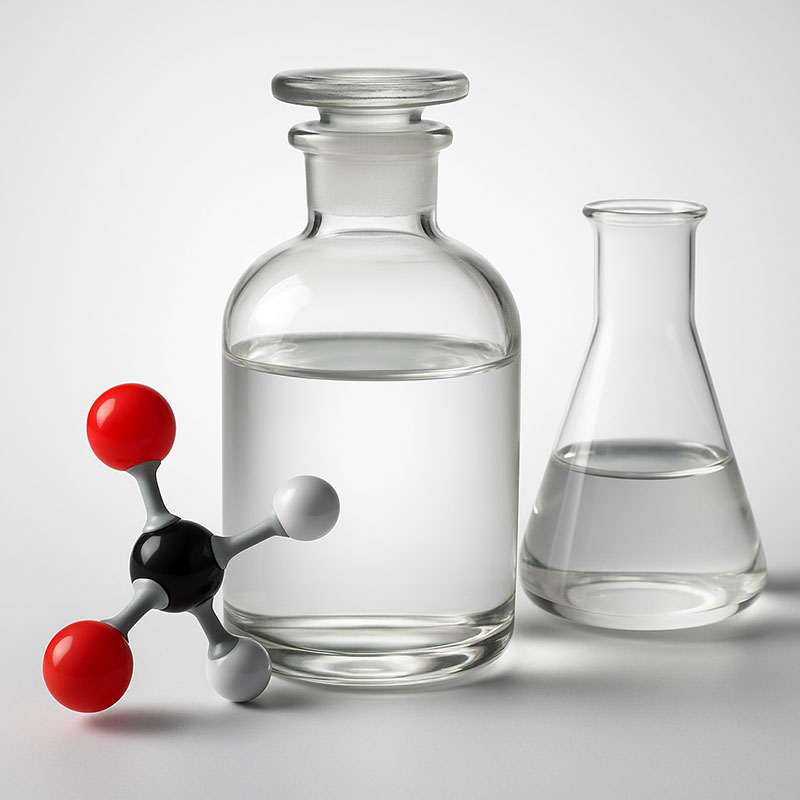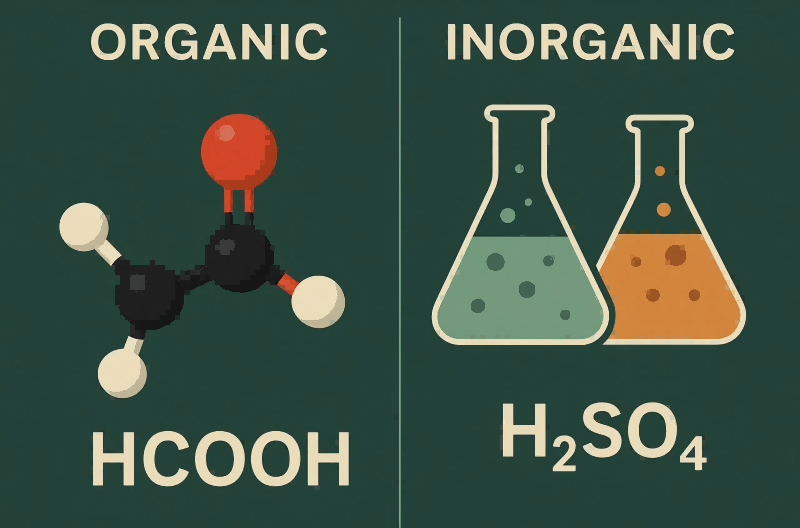Among the many businesses that depend on formic acid (HCOOH), the most basic carboxylic acid, are agriculture, leather processing, pharmaceuticals, and rubber production.Despite its widespread application and chemical simplicity, a recurring question arises in academic, commercial, and industrial contexts: Is formic acid organic or inorganic?
What is Formic Acid?
With only one carbon atom, formic acid (HCOOH) is the most basic member of the carboxylic acid family. The structure consists of:
- A hydrogen atom (H)
- A carboxyl group (-COOH)
Its IUPAC name is methanoic acid, and it is naturally found in ant venom and stinging nettles. The Latin word formica, which means ant, is actually where the word “formic” originates.
Key Physical and Chemical Properties
| Property | Value |
| Molecular Formula | HCOOH |
| Molar Mass | 46.03 g/mol |
| Melting Point | 8.4°C |
| Boiling Point | 100.8°C |
| Density (25°C) | 1.220 g/cm³ |
| Solubility in Water | Miscible |
| pKa | 3.75 |
It acts as a colorless, pungent-smelling liquid that is miscible with water and many polar organic solvents, making it highly versatile in a range of applications.
Organic vs. Inorganic: The Classification Criteria
To determine whether a substance is organic or inorganic, we refer to standard definitions in chemistry:
- Organic Compounds: Include hydrogen and carbon, frequently forming C-H bonds. These compounds typically originate from living organisms or are synthesized in labs to mimic biological molecules.
- Inorganic Compounds: Don’t mostly consist of carbon-hydrogen structures. Examples include salts, metals, minerals, and simple carbon-based compounds like CO₂, CO, and carbonates.
Why Formic Acid Is Classified as Organic
Although formic acid is small and simple, it is classified as an organic acid. The reasoning is as follows:
- Presence of Carbon: Its molecular structure (H–COOH) includes a carbon atom bonded to both a hydrogen and a hydroxyl group (–OH), making it the simplest member of the carboxylic acid family.
- Carboxyl Group (-COOH): The defining feature of organic acids, this group is responsible for acidic behavior in a wide range of organic molecules.
- Participation in Organic Reactions: Esterification, oxidation, and decarboxylation are just a few of the common organic reactions that formic acid goes through.
Thus, despite its simplicity and somewhat borderline appearance, formic acid falls firmly under the organic classification in both academic and industrial chemistry.

Comparison with Inorganic Acids
To understand better, let’s compare formic acid with a few common inorganic acids:
| Property | Formic Acid (HCOOH) | Hydrochloric Acid (HCl) | Sulfuric Acid (H₂SO₄) |
| Carbon-containing | Yes | No | No |
| Molecular type | Carboxylic Acid | Binary Acid | Oxyacid |
| Origin | Biological/Synthetic | Mineral/Synthetic | Mineral/Synthetic |
| Reactivity | Organic reactions | Inorganic reactions | Strong oxidizing agent |
| Industrial Applications | Organic synthesis | pH control, cleaning | Fertilizers, dyes |
Formic acid, unlike HCl or H₂SO₄, has a dual identity in some contexts — being used in reactions alongside both organic and inorganic substances — but its chemistry is dominantly organic.
Origin and Natural Occurrence
Formic acid was first extracted from ants (Latin: formica), which explains its name. Many insects and some plants use it as a defense mechanism. It also occurs in nature through:
- Nettles and bee stings
- Anaerobic fermentation in animal intestines
- Atmospheric oxidation of methane and other hydrocarbons
Its natural origin and biological roles further emphasize its classification as an organic compound.
Industrial Production Methods
Formic acid is industrially synthesized via several methods, and while some pathways may involve inorganic reactants, the product is chemically organic.
Main Production Routes
Methyl Formate Hydrolysis
CO + CH₃OH → HCOOCH₃ (methyl formate)
HCOOCH₃ + H₂O → HCOOH + CH₃OH
Oxalic Acid Cleavage
(COOH)₂ → CO₂ + HCOOH
Carbonylation of Methanol
This is the most commercially adopted route.
Regardless of the pathway, the resulting formic acid retains organic characteristics due to its molecular structure and carbon-based functionality.
Applications in Industrial Sectors
Understanding formic acid as an organic compound is crucial for its safe use and functional application in various industries.
Agriculture
Used as a silage preservative and antibacterial agent, formic acid prevents mold and bacterial growth in livestock feed.
Leather Tanning
As a pH regulator and masking agent, it facilitates the penetration of tanning agents into hides.
Rubber and Latex Coagulation
Formic acid is preferred for natural rubber coagulation due to its organic nature and minimal contamination.
Textile Industry
It’s used to fix dyes and regulate pH in dye baths, especially in acid dye processes.
Pharmaceuticals
Acts as an intermediate in the production of drugs, especially those involving carboxylic acid derivatives or esterification.
Cleaning Agents and Descalers
Formic acid is less corrosive than strong inorganic acids, making it suitable for household and industrial descaling products.
Environmental Behavior and Biodegradability
From an environmental perspective, formic acid is biodegradable and breaks down quickly in natural systems. Unlike strong inorganic acids that may persist or cause hazardous runoff, formic acid is absorbed and decomposed by soil and aquatic microbes.
This eco-friendly behavior is typical of organic acids, supporting its classification and making it attractive for green chemistry applications.
Safety and Handling Considerations
Health Hazards
Despite being organic, formic acid is corrosive and can cause severe burns upon contact with skin or eyes. Respiratory discomfort can result from inhaling fumes.
Storage Guidelines
- Store in cool, dry, and well-ventilated areas.
- Use corrosion-resistant containers (stainless steel or HDPE).
- Keep away from strong oxidizers and alkalis.
Personal Protective Equipment (PPE)
Operators handling formic acid should wear:
- Chemical-resistant gloves
- Safety goggles
- Fume hoods or respirators (in case of vapor exposure)
Even as an organic acid, its handling protocols resemble those of some inorganic acids, particularly in high concentrations.
Analytical Detection and Quality Control
Assay and Purity Testing
- Titration: For acid value determination.
- Gas Chromatography: For concentration and impurity detection.
- IR Spectroscopy: To identify functional groups (notably the C=O and O–H bonds).
Purity grades vary by application:
- Technical grade (85–90%): Used in agriculture, tanning, and cleaning.
- Analytical grade (≥98%): Used in pharmaceuticals and laboratory research.
Role in Organic Chemistry
Formic acid serves as:
- A reducing agent in synthetic chemistry
- A formylating agent in peptide and amine synthesis
- A precursor to esters and formamides
These roles emphasize its contribution to organic synthesis pathways, further reinforcing its identity as an organic acid.
Misconceptions and Gray Areas
Some people assume formic acid is inorganic due to its strong acidity and similarity to mineral acids in use and handling. However, acidity alone is not a reliable indicator of organic/inorganic classification.
Also, its production from gases like CO (considered inorganic) confuses some users, but the end product’s structure and function determine its classification, not the feedstock alone.
Whether you’re formulating a pharmaceutical intermediate, preserving silage, or cleaning industrial equipment, recognizing formic acid as an organic acid allows for more informed, efficient, and safe usage in modern industry.

